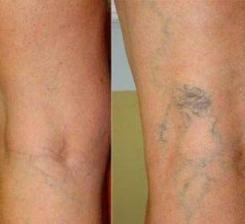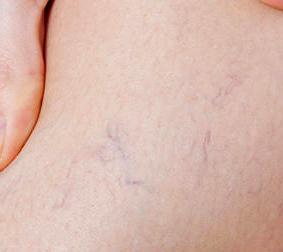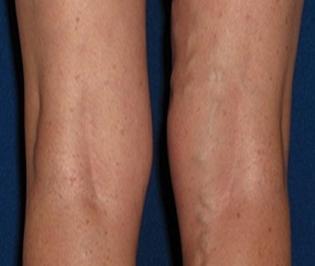varicosity veins of the legs – and not just a cosmetic problem of concern that people have about their attraction, but also a dangerous disease that requires treatment appropriate and compliance with prevention measures.
Causes of varicose veins are a lot: from a sedentary lifestyle, physical overload and ending with hormonal failure, congenital weakness of the vascular wall, pregnancy. What happens during a varicosity? The varicose expansion of the veins of the lower extremities, they lose the normal elasticity and under the pressure of the blood section.
The valves of the veins in the normal state are defined by locks, and when the blood passes through them, is close by, and offer the possibility of reversing the flow of blood. If there is a failure of the valves, the blood can freely be delivered down, which leads to the stagnation of the blood.
In this sense, the veins can not cope with the pressure, are dilated, the valves, as they are not able to block the large office - all this provokes the appearance of the initial stage of varicosity.

The causes of varicosity
For which there is varicosity, and what is it? The main risk factors for the development of the disease is considered to be the genetic predisposition and gender. Love the high calcibus, hormonal changes during pregnancy and the oral contraceptives, women are the victims of varicosity two times more often than men.
The development of the disease contribute to:
- The inheritance. Between the inheritance itself is not a disease, but a genetically determined structure of the veins: weak connective tissue, venous wall, congenital defect of the valves of the veins. It is for this reason that varicosity can occur in young, otherwise healthy and active (regardless of gender) of the people and even in children. According to the scientists, the genetic predisposition is the main factor that leads to varicose expansion of veins of feet.
- Hormonal changes. Because of the peculiarities of the body in women, the periods of hormonal failures of the causes of the stagnation of the blood. For them, the most dangerous periods – puberty, pregnancy, the time after delivery. Also dangerous time, when menopause occurs. This sexual category of patients was doctors 2-3 times more often. In the bodies of women do not have enough of the hormones called estrogen. On the other hand, what prevails is the so-called hormones of the corpus luteum. It is believed that relaxing the muscles. This contributes to the appearance of varicose veins.
- Sedentary, sedentary lifestyleor job that requires time stay standing, contributes to the development of varicose veins.
- Age. With time, the valves and the walls of the veins become, in the end, this leads to the interruption of its work.
- Obesity. The excess weight causes an increase in the load on the veins of the legs.
Secondary varicosity occurs when a leg, injuries, heart defects, liver and spleen. In this case, the first to receive the proper treatment of the main diseases.
The stage of varicosity
It is possible to allocate 3 stages of the progression of the symptoms in the development of varicosity.
- The compensation stage. There are No complaints. In an exam, there are varicose veins in one or both legs.
- Stage sub-awards. When they see in the visible legs pronounced varicose veins. The patients complain of the sensation of fullness, paresthesia ("tingling") in the legs, night cramps. A slight swelling of the feet, ankles and shins in the night. In the morning the swelling disappears.
- Phase of decompensation. To join the list of signs of dermatitis, eczema. Patients concerned about the itching. The skin becomes dry, shiny, well-point with subcutaneous fat. Small hemorrhages and subsequent deposition of hemosiderin cause of the hyperpigmentation.
If varicosity is not considered a very serious disease, but if it is already developed, on their own will never pass, and even more, the progress, the door to all sorts of complications, which are the most dangerous.

Signs of varicosity
The first signs that indicate the onset of varicosity:
- weariness of the legs;
- the swelling of the lower limbs;
- a feeling of heaviness in the legs.
In the later stages it is possible to observe the appearance of spider veins in the skin, which protrude out of the veins and several seals, indicating stagnation in the vessels.
The symptoms of varicose veins in the legs
In the different stages of the varicosity of the veins the symptoms can range from almost asymptomatic small vascular "stars" and serious painful symptoms.
To suspect the development of the initial phase can be symptoms:
- the pain in the legs, sensation of heat, and sometimes with burning sensation through the veins of the legs;
- heaviness in the legs;
- in the evening there swelling in the legs;
- night cramps of the feet;
- dilation of the veins,
- calf leather is a dark colour, there are seals, possible ulcers.
After having had any primary symptoms, you should immediately proceed to the treatment of varicose veins – symptoms, by themselves, will not disappear.
Diagnosis
To diagnose varicosity of the lower extremities and to plan the treatment, the specialist will suggest patient to pass a comprehensive examination, which includes a variety of methods.
- Duplex scan (ultrasound of the veins), the most informative method of diagnosis of varicose veins of the legs, which allow it to obtain an idea of the scope of the varicose veins, the direction of the flow of blood through the veins and their patency and to detect the presence of blood clots (thrombus).
- Contrast venography, which is a survey method that allows us to detect the enlarged veins, and to know the degree of their permeability for blood.
To diagnose deep venous varicosity may only qualified doctor.
The consequences
Complicated course varicosity accompanied by the formation of thrombosis and inflammation of veins, trophic ulcers and skin disorders. These complications are manifested in the discoloration of the skin on the feet, rubore, dimout, venetus of the skin.
Also it is characterized by the persistent swelling of the ankle, especially severe when walking or standing. In calf have pain when walking, pain along the twisted veins, induration in the skin and the formation in it of ulcers of different sizes.
Prevention
If you have a tendency to this disease, the following guidelines will help to slow down its progression:
- Wear comfortable shoes without heels or low heels.
- With a lot of you can make a bandage for the legs or use a medical point things, but only after consulting a doctor.
- Do not stand or sit in one place too long – movement, exercise, change the position of the body.
- Do not take hot baths, especially in the morning – better to replace them with a warm shower with a final cold douche.
- Stop Smoking, which worsens the condition of blood vessels.
Primary prevention is a moderate physical activity: swimming, walking, Biking, loading.
During pregnancy
Pregnancy increases the risk of varicosity of the veins of the lower extremities, this is provided for the following reasons:
- The Hormones circulating in the blood during pregnancy, increases the distensibility of the wall and venous and contributes to the stagnation of the venous blood in the legs.
- The increase in intra-abdominal pressure in late pregnancy hinders the blood flow through the veins of the legs.
- varicosity of the veins that occur during pregnancy can happen after childbirth, or to move more, depending on individual factors (heredity, the presence of other factors).

Treatment of varicosity of the veins of the legs
If varicose veins on the legs treatment may not be medically necessary if the symptoms are not problematic.
However, some people may want to treatment of varicose veins for cosmetic reasons, because they are satisfied with their appearance.
Let's look at basic methods that will help you to get rid of this problem.
- Sclerotherapy. This method of treatment is used both alone and in combination with treatments conservative. Consists of the vein with a fine needle or syringe to introduce, signantes drug, later Vienna disappears completely. The Sessions are held once a week, it takes 3 to 6 sessions. The method allows to avoid scars.
- Non-surgical treatment. If the varicose veins in the initial phase, and if you don't cause too much discomfort, it may be advisable to elastic compression stockings. Use them during everyday activities. They help to compress the veins, keeping them from stretching and limits of any discomfort or pain.
- Medication relieves the symptoms of varicosity, reduces swelling and pain and slows down the process of development, but can not stop the disease entirely and restore the damaged veins.
- Laser treatment of varicose veins of the legs can be used on the surface of the skin. With a small spark of laser light in the wall of the vein develops the process and sclerosing varicose veins disappear, as if she had removed.
An important role in the treatment and prevention of playing a physical activity — walk at brisk, gymnastics, swimming or exercises in the water (excluding sports exercises with a heavy load on foot — tennis, weight lifting, jumping).
Drugs venotonics
The action of these drugs is aimed at increasing the tone of smooth muscles in the walls of the vessel, and to preserve its elasticity and normalize blood circulation in the affected areas.
Many of venotonics are drugs with complex action. The effect that is achieved when their use is not only Vienna, but all the blood vessels of our body.
How to treat varicosity of the veins folk remedies
There are many methods of treatment of varicose veins of the legs folk remedies, for both exterior and interior use. Below are the most common:
- The flowers of horse chestnut (50 grams) required to fill in 500 grams of alcohol, and then let it stand for 14 days, each day shaking the bottle. Pass the infusion through the mesh and eat a spoonful with water three times a day before meals. So you have to try for a week, then take a break of two weeks. Then, the treatment can begin again.
- The infusion of stinging nettle dry used for varicose veins. Dry powder leaves of the plant is poured into the thermos bottle 1/2 liter of boiling water, to insist 30-40 minutes, strain and take 1/3 Cup 3 times a day 1 hour after meals.
- Pack of tomatoes. Finely chopped tomato, which are found in bandages, gauze, and apply to the affected area. For more convenience, you can tie the elastic or other bandage. The celebration of this compression of the vein in 2 hours, then changed for a new one, and so a total of 3 times. The convenience of this group is that you can repeat every day.
- Tincture of oil of new immature walnuts crushed, pour the mixture into a glass bowl, pour the olive oil and of 40 days to insist in a Sunny place. Ready tincture to lubricate sore spots. The treatment course is long, as with kalanchoe.
In addition to folk remedies, many patients varicosity complementary therapy with special exercises in order to feel a significant improvement in allowing the exercise Mikulina.




































